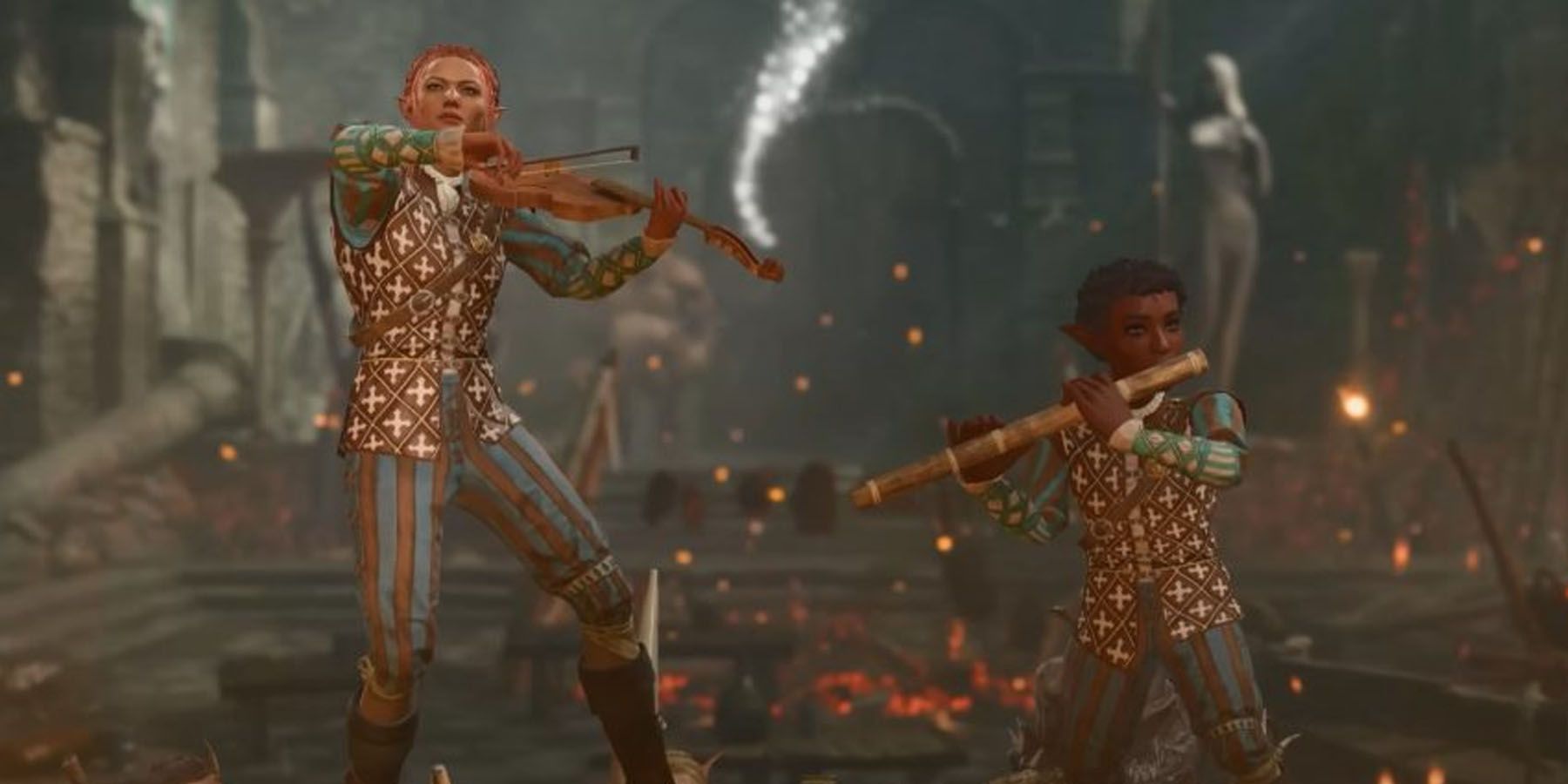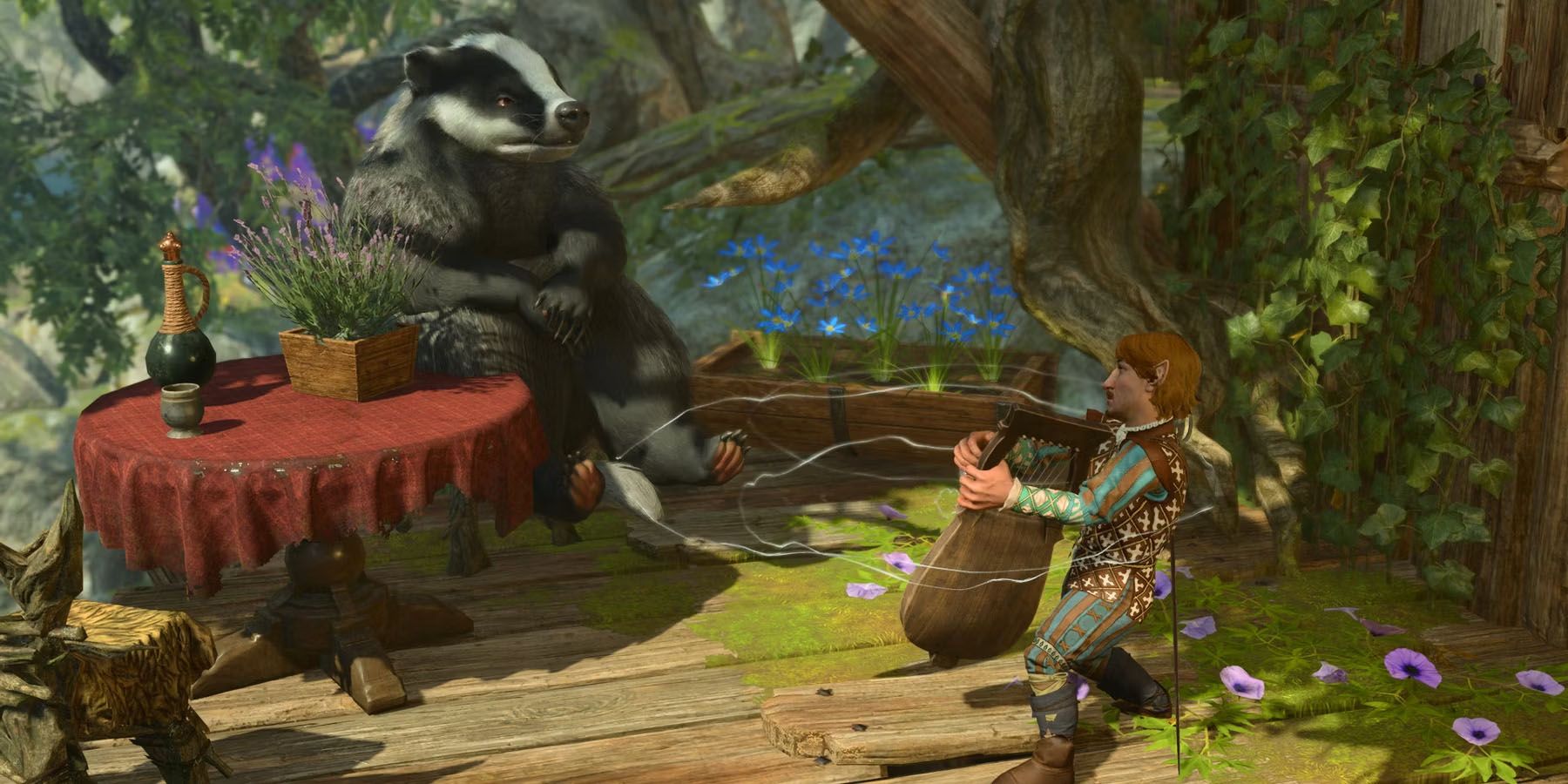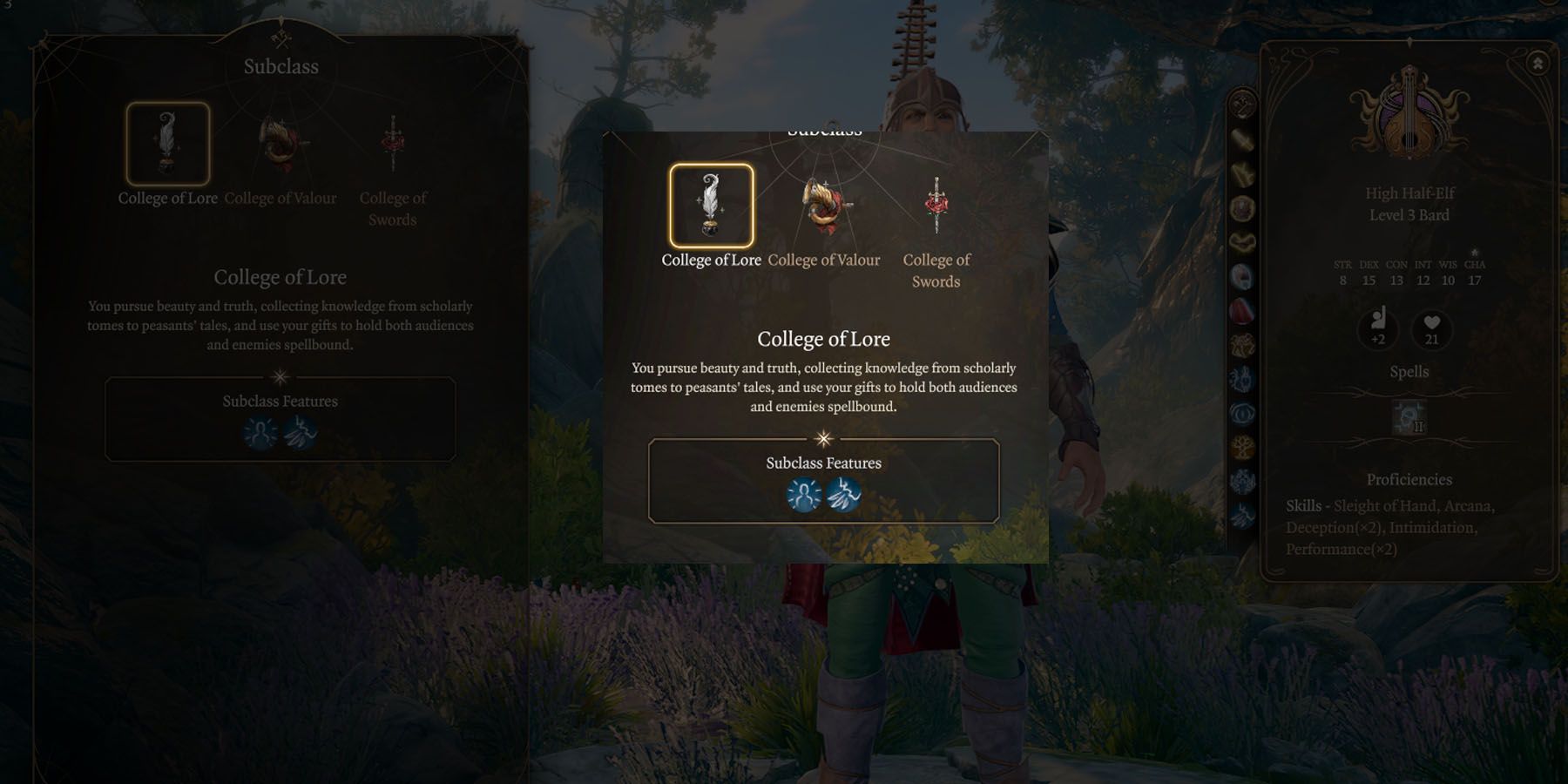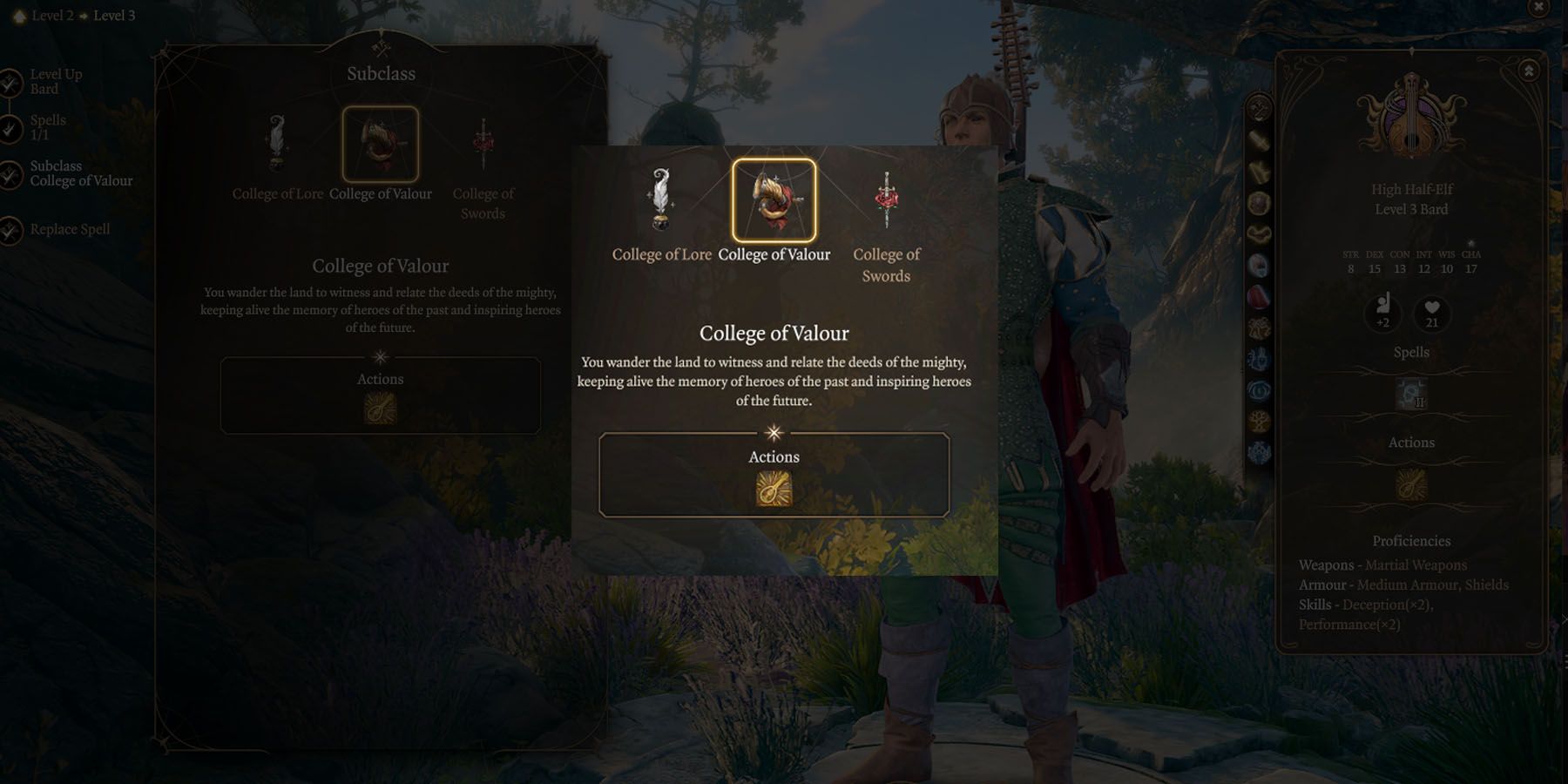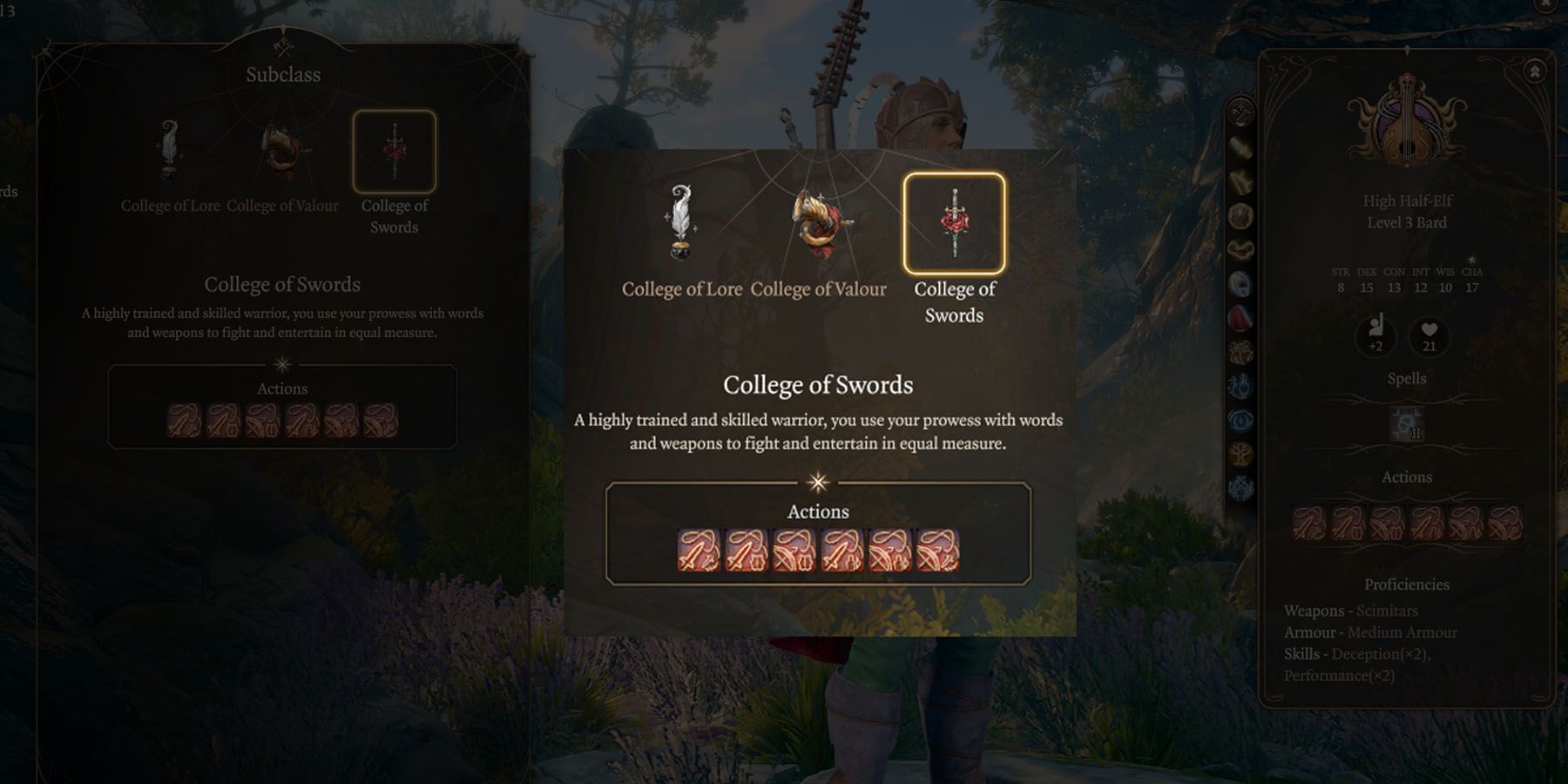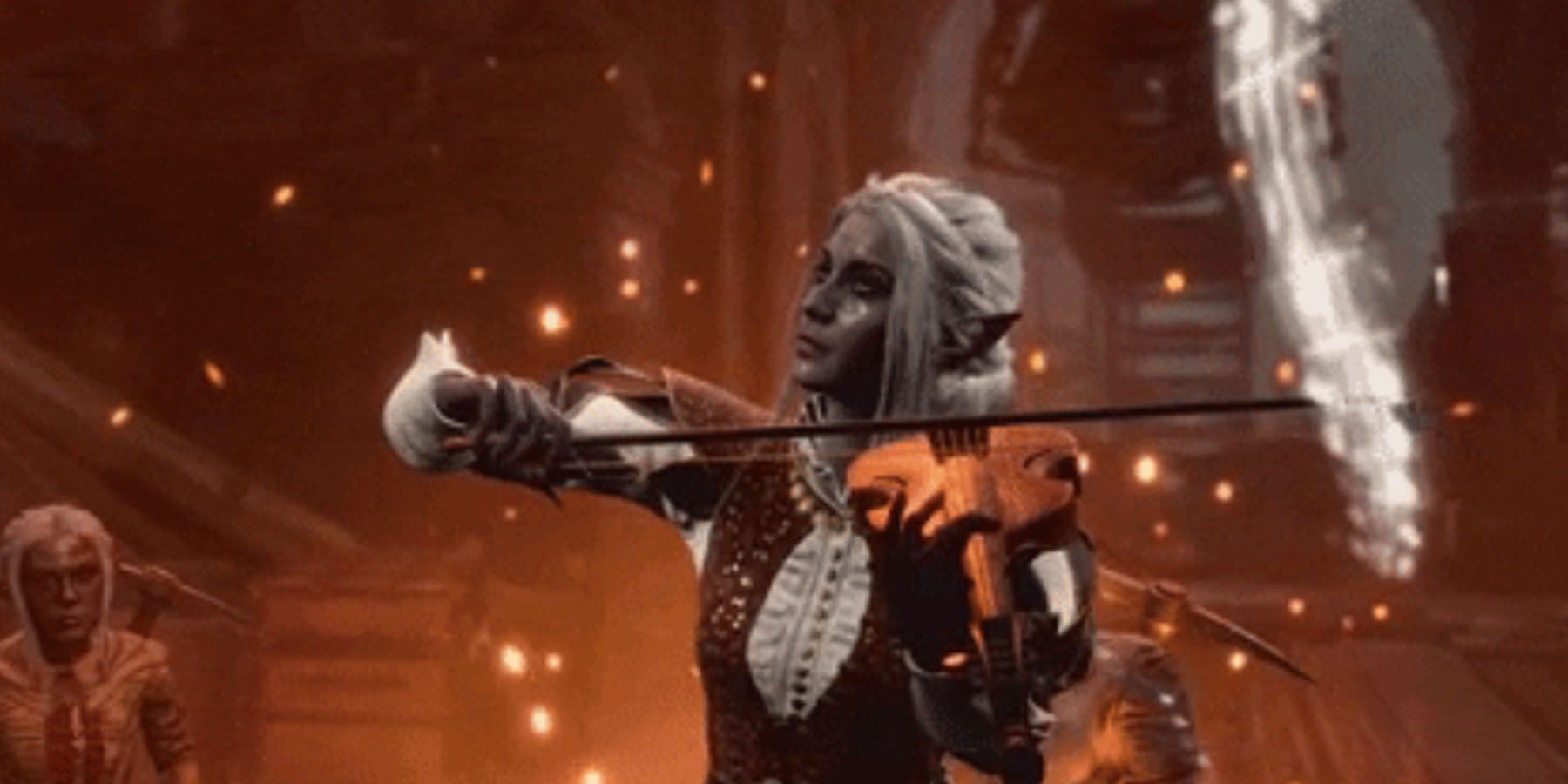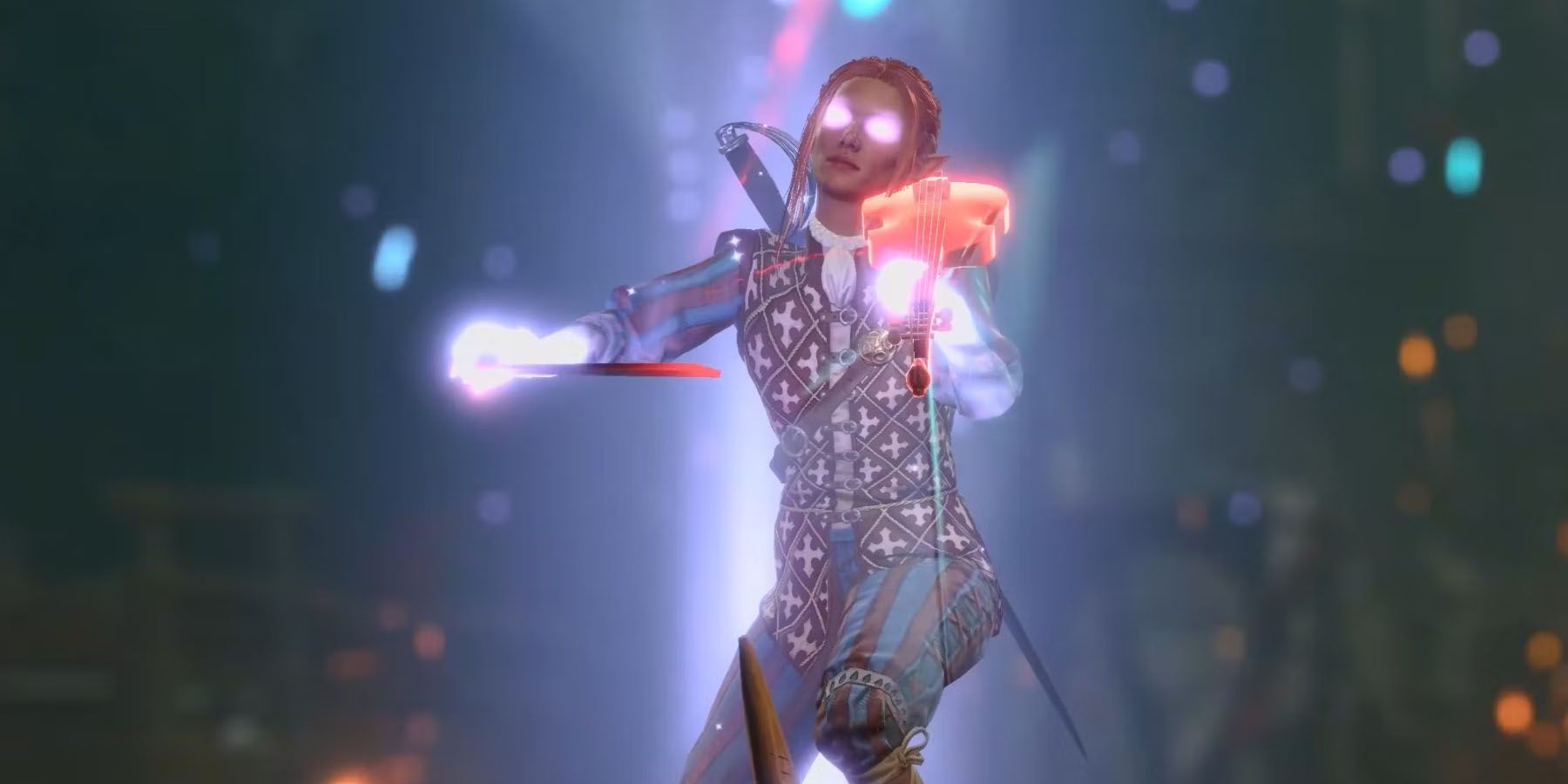Quick Links
Players of classic CRPGs know the sheer intensity of the storylines in the Baldur’s Gate series, making Baldur’s Gate 3 a much-awaited sequel for fans of narrative-focused games. This time around, players of the Baldur’s Gate title get stuck in the middle of an ongoing mind-flayer invasion of Faerun, with only their chosen Class and skillset as a means to fight this seemingly-insurmountable threat.
Players who want to pull off the characteristic Bard from Dungeons & Dragons might want to tailor their Baldur’s Gate 3 Bard to achieve maximum performance and look into possible optimization options for their character. However, just how could players pull off the perfect Bard?
Updated on March 9, 2024, by Rhenn Taguiam: With Baldur’s Gate 3 implementing Hotfix #20 to make adjustments to the acclaimed D&D 5e adaptation, fans of the video game may be wondering how the update's bug fixes may be able to aid players in fully realizing their dream builds. For players who want to maximize the potential of their minstrels and songbirds, Bards can be an ideal choice to bring in an entertaining party member who can also become one of its most efficient units. However, for fans who want to make the ideal Bard build, they may want to figure out just which equipment are best for them to wear as they make progress through their levels, especially when overcoming the game's threats across each Act.

Best Action RPGs To Play If You Like Baldur's Gate
Baldur's Gate is one of the greatest and most influential games ever. Here are some action RPGs fans of BioWare's title should enjoy.
Bard Class Overview
Players of the Baldur’s Gate game who aren’t familiar with its original sourcebook Dungeons & Dragons 5e might not be entirely sure what to expect from the Bard Class. Considered one of the starting Classes in D&D 5e, the Bard serves as a staple character build for players looking for a decent mix between a utility and combat character. Although usually joked around as a promiscuous archetype due to their incredibly-high Charisma, here are other reasons why a Bard may be a player’s go-to Class:
- Bardic Inspiration: As the Class’s most unique feature, Bardic Inspiration is a massive buff that Bards can give their allies, allowing them to add extra dice to any d20-based roll. This value increases as Bards level up.
- Abilities: Charisma and Dexterity, wherein CHA allows players to cast powerful spells and utilities to play with the battlefield while having enough DEX to dish out decent damage in weapon combat.
- Spellcasting: Using CHA as their Spellcasting Modifier, Bards may be able to cast Spells that allow the party to gain various advantages in combat while making interactions outside fighting a breeze.
- Subclass - College of Lore: Serving as the more scholarly specialization of Bards, the College of Lore gives Bards more access to utility spells that serve to aid allies more effectively in combat.
- Subclass - College of Valor: Serving as the combat-based specialization of the Bards, the College of Valor gives Bards access to more offensive-leaning abilities that enable them to become frontline attackers.
- Subclass -
- Starting Instrument
- Players can select an instrument from various musical implements as Bard’s tool. This simply changes the overall sounds of the game when casting Spells and can be changed by switching to another instrument.
- Saving Throw Proficiencies: Dexterity, Charisma
- Players add their Dexterity and Charisma Proficiency Bonuses to their Saving Throws, making Bards more capable of dodging deadly attacks (Acrobatics) or even resisting truth-telling Zone of Truth Spells.
- Proficiency, Light Armor
- Thanks to this proficiency, Bards won’t impose attack disadvantages or prevent spellcasting even when wearing Light Armor.
- Proficiency, Weapons (Simple, Hand Crossbow, Longsword, Rapier, Shortsword)
- These proficiencies allow the Bard to add their Proficiency Bonus when making Attack Rolls, increasing their odds of hitting foes.
The Race: Guarantee Spellcasting
As with most builds that focus on creating ideal Classes, the best Races are often the ones that maximize the boosts players can give to a particular Ability Score. Being a Charisma-heavy Class, the Bard needs to pack a lot of Charisma to ensure they can cast their most formidable Spells successfully. Thankfully, certain Races available to parties in the Baldur’s Gate title can help players maximize their Bard’s performance in the thick of battle:
- Wood Half-Elf: Traditionally, Wood Half-Elves retreat to quiet lives in the forests of Faerun. For the Wood Half-Elf, their half-heritage drives them to continue journeying across the rest of the Realms. As Half-Elves, they give Bards the Fleet of Foot (walking speed becomes 10.5m) and Mask of the Wild (Stealth Proficiency), making the Wood Half-Elf Bard ideal for long-ranged builds.
- Drow: Although relatively unknown due to their lives underground, the Drow are infamously known for worshipping Lolth. However, this is only true for their Lolth-Sworn variants, as Seladrine Drows hope to break away from their association with the dark deity. As Drow, players gain Fey Ancestry, which gives them an Advantage when saving against being Charmed and immunity to sleep, alongside Superior Darkvision (see in the dark within 24m). Even without light, their Dancing Lights (Evocation Cantrip) can illuminate a 12m-radius area. Most importantly, they also gain Proficiency (Rapier, Shortsword, Hand Crossbow). Thanks to proficiency in D&D Versatile Weapons alone, the Drow is ideal for maximizing a Bard’s potential arsenal.
- Human: Being the most common Race in Faerun, Humans are found building lives almost anywhere. What they lack for racial features, they compensate for by getting an extra skill to be proficient with. Because Bards are already so great at skill checks, this just further guarantees success in dialogue. Humans are an ideal Race for a “balanced” Bard build.
The Background: Emphasize On Charisma
While the Bard in Baldur’s Gate 3 specializes in both Dexterity and Charisma, it still follows its original Dungeons & Dragon counterpart that emphasizes Charisma for its combat advantage. Most especially, they need Charisma to be able to impress or intimidate their way past foes, which are Skills that these Backgrounds transform into proficiencies:
- Criminal (Deception, Stealth): An expert in breaking the law and getting away with it, Criminals are more than able to slip into the shadows when needed. Their Deception Proficiency allows them to lie without much consequence, while Stealth allows them to blend into shadows more efficiently, perfect for surprise attacks. This is the ideal Background for offensive, stealth-heavy builds.
- Guild Artisan (Insight, Persuasion): Their skill in their trade makes the Guild Artisan an expert in niche topics, perfect for a Dungeons & Dragons build centered around the traveling craftsman. Their Insight Proficiency lets them gleam knowledge on things they notice, while their Persuasion Proficiency lets them convince others to lean over their side. This is the ideal Background for talking-heavy builds.
- Soldier (Athletics, Intimidation): Trained in various battlefield strategies, the Soldier is both brave and smart in the heat of battle. Their Athletics Proficiency allows them to perform incredible feats of strength, while Intimidation allows them to scare people into submission.
- Charlatan (Deception, Sleight of Hand): Possessing a special knack for twisting their words, Charlatans can make allies turn on each other for profit and amusement. Their Deception Proficiency allows them to fool others, while Sleight of Hand makes thieving easier.
- Noble (History, Persuasion): Being raised in a prominent family, the Noble prioritizes acquiring loyalty, renown, and power. Their History Proficiency lets them identify interesting pieces of ancient knowledge from various situations, while Persuasion allows them to see others on their side.
The Ability Array: Life Takes Second Priority
As with other RPGs similar to Dungeons & Dragons, it makes sense for Baldur’s Gate 3 players to want to prioritize an Ability Array that focuses on the Bard’s greatest strengths: that being Charisma and Dexterity. With the above considerations taken into account, here is an ideal setup for an Ability Array that maximizes the Bard’s performance in the early game:
- Strength 12 (+1): In worst-case scenarios, Strength could become a Bard’s combat Ability, especially for melee builds. However, given how Strength contributes towards Encumbrance, this should also be considered.
- Dexterity 14 (+2): As the Bard’s primary combat Ability, Dexterity should take a secondary or tertiary priority. Ranged Bard builds will use DEX for long-ranged weapons, while DEX could also substitute for STR for Versatile weapons, which also count towards the Bard’s specialization.
- Constitution 16 (+3): As the game’s primary determinant of Hit Points, Constitution should become paramount for the support-based Bard. CON should be equal to or as close to CHA as possible regarding stat distribution.
- Intelligence 8 (-1): Considering how there are not many things Bards do that need INT that the resident spellcaster doesn’t cover, Intelligence could become a dump stat.
- Wisdom 10 (0): Seeing how there are not many things in-game that require a WIS Save or an active WIS Check from the Bard, Wisdom could become a neutral stat.
- Charisma 16 (+3): The bread and butter of the Bard’s build, it’s important they get as high Charisma as possible to maximize the output of their D&D Spells.
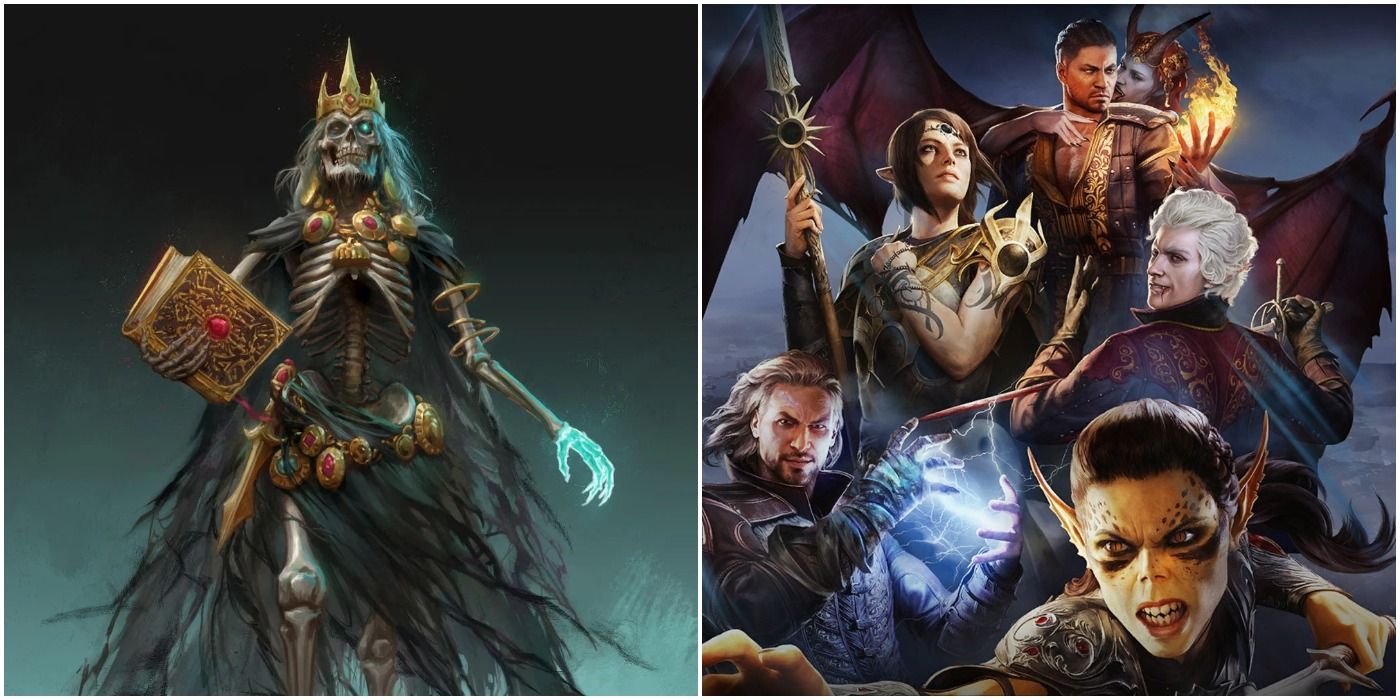
Baldur's Gate 3: 10 NPCs From Other 5e Campaign Settings That Should Make A Cameo
While Larian Studios' Baldur's Gate 3 is set in Dungeons & Dragons' Forgotten Realms, that does not mean NPCs from other settings cannot show up.
Bard Colleges
Unlike other Classes in Dungeons & Dragons, the Bard of Baldur’s Gate 3 cannot pick a subclass or an archetype until Level 3. This time called a Bard College practically “cements” the Bard’s specialization throughout the game. Depending on the player’s choice of role, the Bard may be tailored to become a healer via the College of Lore, a combat expert via the College of Valor, or a fighting specialist via the College of Swords. Here are things to take note of:
College Of Lore: Outside Battle Matters Too
Bards who choose the College of Lore value knowledge and truth more than anything else and spend the rest of their days collecting wisdom and lore wherever they see it. They don’t care much about combat but rather relish in the pursuit of information. Support builds can rely on the College of Lore Bard for outside-combat maneuverability, especially with their additional Proficiencies. Here are other things to take note of:
- Cutting Words (Class Feature): With this ability, the Bard can force a 1d6 penalty toward Attack Roles, Ability Checks, and Damage Rolls to an opponent until the beginning of their next turn. Think of this as a negative Bardic Inspiration designed to debilitate the enemy’s combat performance.
- Arcana, Intimidation, Sleight of Hand (Proficiency)
College Of Valor: Cementing Offense
Players who want their Bard to capitalize on their combat potential in Baldur’s Gate 3 may want to choose the College of Valor. This College trains their Bards to keep an eye out on heroes around them, ensuring they stay alive to tell their tales - meaning they have to train to become the heroes they idolize. Players should choose the College of Valor if they want to perform better in combat, particularly at close range. Here are things to note:
- Combat Inspiration: An upgraded form of Bardic Inspiration, the affected creature can now add the +1d6 bonus to their Damage Roll or use it to get +4 AC against one attack, allowing them to bolster the attack power or defensive capabilities of their allies.
- Medium Armor (Proficiency)
- Shields (Proficiency)
- Martial Weapon (Proficiency)
College Of Swords: Optimizing Strategy
Serving as more or less the performance-inclined version of the Battle Master, the College of Swords serves as the Bard Archetype specializing in heavy-hitting combat strategies. This College encourages Bards to explore new armaments like Versatile Weapons to expand their combat strategies. They get a slate of more versatile attack styles that can enhance their role in a fight, of which the following should be noted:
- Slashing Flourish: Available to both melee and ranged attacks, this deals 1d6 Damage on hit to two adjacent opponents.
- Defensive Flourish: Again usable on both melee and ranged attacks, this deals 1d6 Damage on hit and gives a +4AC bonus to the Bard until their next turn.
- Mobile Flourish: When used as either a melee or ranged attack, players can deal 1d6 Damage, push an enemy 6 meters, and then Teleport beside them.
- Scimitar (Proficiency)
- Medium Armor (Proficiency)
Level 1-4: Establishing Playstyle
Players who create their Bard for the first time might find the Class a bit rough around the edges. Compared to other Classes in the game, the Bard doesn’t offer much in terms of overall damage and utility, although they do make great early-game Face Characters.
Levels 1 to 4 are the time players need to establish the kind of playstyle their Bards want to use, especially when it comes to using them in combat in relation to their party members. In this level bracket, players should consider the following combat options:
Class Features
- Bardic Inspiration (L1): A buff that can be used 3 times between Long Rests, this adds a free 1d6 bonus to their next Attack Roll, Ability Check, or Saving Throw. Bards should use this as often as possible to buff their stronger allies, especially when they’re about to use big attacks.
- Song Of Rest (L2): This is an Action that serves as a substitute for a Long Rest, usable once per Long Rest. Players should ideally use this as a healing substitute to Short Rests, especially in between unusually difficult encounters.
- Jack Of All Trades (L2): Half of Proficiency Bonus rounded down is now added to Ability Checks players aren’t efficient in. This can be a saving grace in most rolls, as this adds a guaranteed bonus to rolls involving dump stats.
- Expertise, 2 Skills (L3): This doubles Proficiency Bonuses to Ability Checks that use a Bard’s Skill Proficiency, giving them a drastic boost to most Skill Checks.
Spell Priority
- True Strike (Cantrip): Advantage-reliant allies such as Rogues could benefit from this Cantrip.
- Vicious Mockery (Cantrip): Forcing Disadvantage on an enemy Attack Roll on top of 1d4 Psychic Damage makes for a decent emergency attack.
- Healing Word (Level 1): A long-distance heal is always beneficial in case of emergencies.
- Thunderwave (Level 1): 2d8 Thunder Damage on top of the possibility to push enemies can help break enemy formation.
- Sleep (Level 1): Sleep can help players facilitate quite a lot of shenanigans, especially related to Pickpocketing.
- Shatter (Level 2): Essentially an upgraded Thunderwave, 3d8 Thunder Damage with a CON Save can eliminate multiple enemies quickly.
Feats
- Defensive Duelist: When attacked while holding a Finesse Weapon, Bards can use a Reaction to add their Proficiency Bonus to their AC. In situations where Bards can’t afford to get hit by an attack, this can be a lifesaver.
- Dungeon Delver: Bards get Advantage to Perception Checks when detecting hidden objects and to Saves to avoid traps. They gain Resistance to trap damage as well. Given how their bonuses can help them Disarm Traps they see, being able to spot them beforehand could be useful.
- Moderately Armoured: This gives the Bard Proficiency with Medium Armour and Shields, on top of +1 to either Strength or Dexterity. Depending on the Ability Array, a +1 to Dexterity could add a much-needed +1 bonus to rolls.
Gear, Weapons To Take Note
- Blazer of Benevolence (11 AC + DEX, Light Armour, Uncommon): Given by Volo as a reward for rescuing him in the Goblin Camp, this gear gives players +4 Temporary HP whenever they use Bardic Inspiration to Inspire an ally.
- Leather Armour +1 (12 AC + DEX, Light Armour, Uncommon): When players reach Level 4 but opt out of the Moderately Armoured Feat, this gear is an ideal fallback. Its 12 AC + DEX Modifier can still establish a solid defense for a ranged Bard, especially with high-enough DEX to push the 14-16 AC mark.
- Slippery Chain Shirt (13 AC + DEX, Medium Armour, Uncommon): This medium Armour in the Festering Cove (Act One) is one of the best first pieces of gear to acquire with the moderately armed feat. Its auto-disengage on a heal incentivizes sub-support builds for Bards, allowing them to heal from the frontlines without the risk of becoming targets.
- Adamantine Scale Mail (16 AC + DEX, Medium Armour, Very Rare): Securing this gear at the Grymforge may give players Disadvantage on Stealth, but it's a worthwhile trade-off against never taking Crits, persisting -1 Damage Taken, and giving Reeling against melee attackers. Getting 18 AC out of a Medium Armour as a Bard in the Underdark before going to the Mountain Pass can give them quite the edge against tougher foes.
- Phalar Aluve (1d8+1 Slashing, Longsword, Rare): If players get to the Underdark early in their experience, this weapon may be one of the first they can encounter. Its singing-based mechanics can be perfect for the Bard's themes, with its abilities capable of buffing allies or debuffing enemies.
- Sword of Screams (1d8+4 Slashing +2 Acid +1d4 Psychic, Longswrd, Uncommon): This weapon fits the College of Sword, especially with Dual Wielder that can facilitate extremely aggressive plays.
- The Blood of Lathander (1d6+3 Bludgeoning, Mace, Legendary): The long questline to retrieve this weapon makes it worthy of the acquisition. Not only does it give players a free 2d6 Heal upon 0 HP once per Long Rest, it even gives players the 6th-Level Spell Sunbeam as a freebie. Having access to this Mace as early as Act 1 can give the Bard a significant edge in battles.
Level 5-8: Midgame Adaptability
At this stage in a Bard’s progress as a D&D Class in Baldur’s Gate 3 gameplay, players are advised to experiment with their character’s potential to accommodate multiple roles. Based on their current playstyle, is their Bard suitable as a sub-DPS, a sub-support, or a sub-tank?
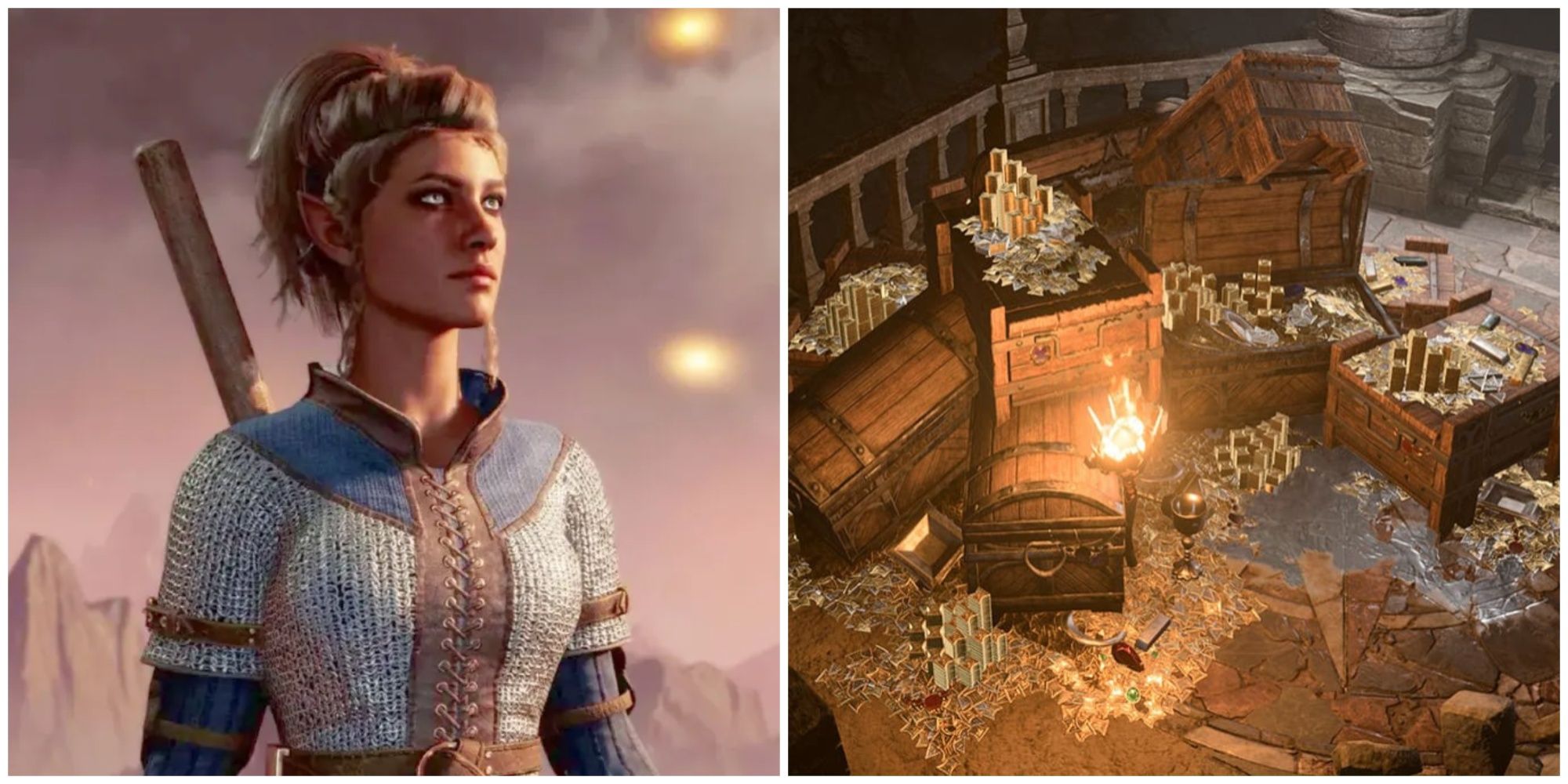
Baldur's Gate 3: 9 Best Hidden Treasures To Find
Finding hidden treasure can be a joy for Baldur's Gate 3 players, especially when they can discover piles of loot and powerful gear.
This choice will dictate the kind of Spells and Feats more applicable to them, especially since the Bard’s roster of new options in this cap improves their overall supporting capacity. Reaching this point in their playthrough should have players consider the following combat options:
Class Features
- Bardic Inspiration (L5): Now usable for 4 times between Short Rests, Bardic Inspiration becomes a 1d8 dice.
- Font of Inspiration (L5): Either a Short or Long Rest will restore all bardic Inspiration charges.
- Countercharm (L6): As an Action, Bards will provide Advantage to Saving Throws against being Charmed or Frightened for all allies within 9 meters.
Spell Priority
- Silence (Level 2): Disabling a spellcaster’s ability to use spells can be debilitating to an enemy squad, forcing them to regroup without opportunities to strike back.
- Knock (Level 2): If the player doesn’t have room to accommodate Knock, this can make for an efficient door-opener, especially for ornate-looking chests and sealed spaces.
- Hypnotic Pattern (Level 3): When positioned correctly, players can disable enemies from moving and attacking. Being WIS-reliant, players may want to do this with a build that has high Wisdom to maximize the difficulty of breaking free.
- Stinking Cloud (Level 3): This action-disabling spell can give players room to form a counter-offensive.
Feats
- Lucky: Since Bards can’t use Bardic Inspiration on themselves, the ability to gain Advantage on Attack Rolls, Ability Checks, and Saves on top of being able to force a reroll on opponent Attack Rolls can be crucial to fights.
- Dual Wielder: This allows Two-Weapon Fighting with non-Light (but not Heavy) Weapons. A combat-oriented Bard could use the additional damage by wielding two Longswords.
Gear, Weapons To Take Note
- Penumbral Armour (13 AC + DEX, Light Armour, Rare): Being able to score 13 AC + DEX Mod as soon as a Bard hits Level 5 can provide a significant boost to their mid-game defenses, especially if they rely on DEX for their general offense. Taking -2 Bludgeoning Damage from opponents is a welcome bonus, especially against mobs.
- Shadeclinger (12 AC + DEX, Light Armour, Rare): While also suitable for Rogues with its Stealth +1 and Advantage on Saves, this is exactly the kind of gear a Bard might need if they're assigned for scouting missions. Players who prefer the Bard to strike last amid an ongoing encounter could use the additional Stealth to maneuver themselves amid hostile forces.
- Barkskin Armour (12 AC + DEX, Medium Armour, Rare): Despite its middling initial AC boost as a Medium Armour, its Forest Aegis effect that bumps the gear into 16 AC makes this a worthwhile addition to a Bard's arsenal. Not to mention, its Advantage to CON Saves also make it safe to wear at any range.
- Scale Mail +2 (16 AC + DEX, Medium Armour, Rare): Its Disadvantage on Stealth can make it rather hassling to wear for ambushers, but a proud Bard wouldn't mind given its +1 Initiative and -1 Slashing Damage Taken. Not to mention, an ideally-built Bard will instantly get 18 AC from this armour, as though they're wearing Heavy Armour. In tougher battles close to Act 3, this gear can become an indispensable part of their arsenal.
- Darkfire Shortbow (1d6+2, Shortbow, Rare): The free Haste alongside Fire and Cold Resistances can make this Shortbow ideal for both offense and defense. Even if Haste is only available once per Long Rest, it can give the Bard and even another ally a much-needed boost to their offensive potential.
- Incandescent Staff (1d6/1d8 Bludgeoning, Quarterstaff, Very Rare): Despite its rather mediocre base damage as a Quarterstaff, its main benefits shine with its Fire Resistance, +1 Ranged Spell Attack, and free casts of Fire Bolt and Fireball. Just Fire Bolt as a Cantrip alone can give the Bard an extra offensive advantage, with Fireball just allowing them to wreak havoc in the battlefield.
Level 9-12: Endgame Cheesing
Players who reach this point in their Bard’s career have likely stuck with a straight Bard build or accessed certain levels of Multiclass to expand their combat versatility in Baldur’s Gate 3. At this point in time, players can make further progress with their Bard to make them the ultimate Skill experts or specialize further in their intended combat roles. These combat options make the Bard more powerful in the endgame:
Class Features
- Bardic Inspiration (L10): Now usable 5 times between Short Rests, Bardic Inspiration transforms into a 1d10 dice.
- Magical Secrets, 2 Spells (L10): Bards are now able to acquire 2 Spells from the Magical Secrets list, allowing them to access powerful Spells from outside their Class.
- Expertise, 2 Skills (L10)
Spell Priority
- Polymorph (Level 4): Being able to transform an opponent into harmless sheep could do wonders against bosses.
- Mass Cure Wounds (Level 5): Being able to provide a massive heal to up to 6 creatures could become a life-saver in extreme emergencies.
- Hold Monsters (Level 5): Paralyzing a creature is only a fraction of this spell’s benefit, as all attacks within 3 meters of the target become Critical Hits, making fighting bosses much easier.
Magical Secrets
- Magic Missile (Level 1): This attack can hit three creatures and never miss, making this a nifty combat spell
- Fireball (Level 3): This popular D&D spell remains deadly when targeting multiple opponents, especially if players can’t attack all of their enemies within a turn
- Mass Healing Word (Level 3): Support Bards could use this Spell in emergencies, especially if the resident Cleric is incapacitated
- Banishment (Level 4): Being able to temporarily remove a being from the encounter for 2 turns could give players plenty of room to kill subordinates and even make a slight recovery
Feats
- Sharpshooter: With high-enough DEX, a Bard wouldn’t even notice the -5 Attack Roll penalty of this Feat. The +10 Damage this provides, however, can kill opponents much faster.
- Magic Initiate (Charisma Class): Getting access to 2 Cantrips and 1 1st-Level Spell from any Charisma Class (Sorcerer, Warlock) could add a lot of utility to the Bard’s repertoire of spells.
Gear, Weapons To Take Note
- Studded Leather Armour +2 (14 AC + DEX, Light Armour, Rare): Upon reaching Level 9, this gear can give a significant advantage to Bards who prefer to stay at any range in combat. Its -1 Bludgeoning Damage Taken buff with +1 Initiative can help Bards get an edge in battle, especially if they're able to cast their Spells first.
- Armour of Landfall (13 AC + DEX, Light Armour, Very Rare): Dealing with either Rolan or Lorroakan can help players acquire this gear, which can be a useful endgame armor for its +1 Spell Save DC, Advantage on CON Saves, and free access to Plant Growth (3rd-Level, Short Rest) that can serve as a free +1d4 HP heal per turn. This gear can be of use to Bards who want to secure easier hits regardless of the weapon builds, with the free HP ensuring the party's healer has less to worry about.
- Unwanted Masterwork Scalemail (16 AC + DEX, Medium Armour, Rare): Being able to add the full DEX Mod of the Bard into this armour instead of the usual +2 Limit can boost their defenses to incredible levels. The Fire Damage Resistance is a godsend against the right enemies in Act 3.
- Flame Enamelled Armour (16 AC + DEX, Medium Armour, Very Rare): Getting this gear in the Wyrm's Rock Fortress may limit the Armour Class boost to 18 AC. However, its +2 Initiative +2 Saves, and free Fire Shield: Warm alongside Fire Resistance are worthwhile trade-offs for decent defense.
- Armour of Agility (17 AC + DEX, Medium Armour, Very Rare): Securing this armour with its full DEX Mod bonus can give a much-needed defensive boost to Bards against the tougher foes of Act 3. Not to mention, its +2 Saves and lack of Stealth Disadvantage can help Bards have a fighting chance against stronger casters.
- Infernal Rapier (1d8+2 Piercing, Rapier, Very Rare): Getting this weapon for Wyll and then giving this to the team's Bard can give players access to the Planar Ally Spell. While only usable once per Long Rest, this extra Cambion ally can significantly add to the player's overall firepower, especially since it's far stronger than a typical pet.
- Duellist's Prerogative (1d8+8 Piercing +2 Piercing +1d4 Necrotic, Rapier, Very Rare): This Longsword is perhaps one of the best weapons for a Bard specifically for its damage output potential. Its Elegant Duellist effect now allows Crits at 19 on top of a bonus Reaction, which can be used in tandem with its Withering Cut to inflict (Proficiency Bonus) Necrotic Damage on a melee weapon attack. Using this with a College of Swords Dual Wielder Bard can catapult the character into main DPS territory.
Multiclass Options
Being one of the most versatile Classes in Dungeons & Dragons, it makes sense for players enjoying their Baldur’s Gate 3 playthroughs to want to try expanding their initial Bard setups. In situations where a Bard needs to pack more combat or utility options, Multiclassing them seems an ideal route to maximize their efficiency. In this regard, ideal Multiclass options include:
- Fighter Optimization: Dipping into Fighter is always an ideal move for any Class, especially the Bard whose slate of utility abilities could use combat enhancements by this Multiclass. Tapping into Action Surge alone gives the Bard more room to unleash attacks and spells, while subclasses like the Battle Master could provide them with more room to punish foes.
- The Classic Ranger: It’s unsurprising for Bard builds to capitalize on Dexterity due to their spellcasting nature. With Dexterity being the pinnacle of flexibility, Bards can enjoy long-ranged bows as well as Versatile weapons. However, this penchant for dextrous movement can lead to a Ranger specialization, giving the Bard expanded combat opportunities via spells or weapon options.
- Other Charisma Classes: Bards boasting high Charisma makes them ideal for Multiclassing into other Charisma-based Classes. Thankfully, this stat benefit also plays into the flavor of Bards being traveling performers, as their misadventures could lead them into starting their Multiclass routes. For instance, a player’s headcanon could involve them upsetting an entity that becomes a Warlock patron or accessing their magical heritage as a Sorcerer, transforming them into utility specialists. Likewise, a Bard could find themselves devoted to a cause, becoming a Paladin that transforms them into sub-tanks.

Baldur's Gate 3
- Platform(s)
- PC , macOS , PS5 , Xbox Series X
- Released
- August 3, 2023
- Developer(s)
- Larian Studios
- Genre(s)
- RPG



